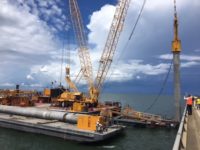Demoed Lake Pontchartrain Bridge Keeps on Giving








When the 5.5-mile Interstate-10 Twins Spans crossing over Lake Pontchartrain was beaten up during Hurricane Katrina in 2005, it seemed to spell the end for the well-used structure. But the team rebuilding it devised a way for its debris to keep giving back to local residents.

The demolished bridges have been repurposed to create a new fishing pier on the north side of the lake. And old materials are being used to create two artificial reefs, each four acres in size, that will provide habitat for marine life and protect shoreline.
“Before you throw an old bridge into the garbage, you must make it public that the material is available for beneficial use,” says Arthur D'Andrea, project manager for the Louisiana Department of Transportation and Development (DOTD).
Slidell, La., which lies on the north shore, sought to retain about one mile's worth of spans for a pier. The city will tie in from land with a timber pier and kiosk that will slowly rise to the elevation of the bridge, D'Andrea says. Minus sections of a temporary Acrow bridge used in emergency repairs, that left between nine and 10 miles of bridge facing demolition.
“We had a small portion of bridge demo in our contract,” says G.J. Schexnayder, project manager for Boh Bros. Construction, New Orleans, contractor for the approaches and low-level portions of the replacement spans. “We broke up some of that material and built a reef out of it in Lake Pontchartrain,” he says. “Being an outdoorsman, it felt good to help out the local wildlife.”
DOTD awarded demolition contractor NASDI, Waltham, Mass., a $27-million contract to remove the 1,000-ft-long main navigational channel spans in one phase, followed by the rest of the structure at a later time. “We finished phase one a month ahead of schedule,” says Brian Clark, NASDI project engineer. “We had to clear 10 spans to eliminate the hazard of the channel being slightly out of line with the new span.” Contract completion date is December 2012.
“We expect to get at least 42 spans from the current phase of demolition for a second reef in St. Tammany Parish,” says Doug Peter, artificial reef coordinator for the Louisiana Dept. of Wildlife and Fisheries. Demolition contractors plan to begin deploying material in early September. Artificial reefs in the area are typically built from obsolete oil and gas platforms. “This is the first time in Louisiana that bridge material was used,” he says.
DOTD and the Louisiana Office of Coastal Protection and Restoration partnered to use most of the demolished material (about 220,000 tons) for shoreline protection in Lake Borgne, the main conduit for storm surge to enter into the eastern side of New Orleans. Bertucci Construction, Jefferson, La., has a $22.8-million contract to crush concrete to the proper gradation, place it in “marine mattresses” and barge it to the site.
NASDI divided the demolition into super- and sub-structure, and is taking the bridge down in 100-ton pieces, Clark says. “For the sub-structure, we're using a 54-inch guillotine shear. We cut up the pilings in two pieces.”
NASDI is using a fleet of 10 barges to move equipment to the site and to transport debris to the staging area.





